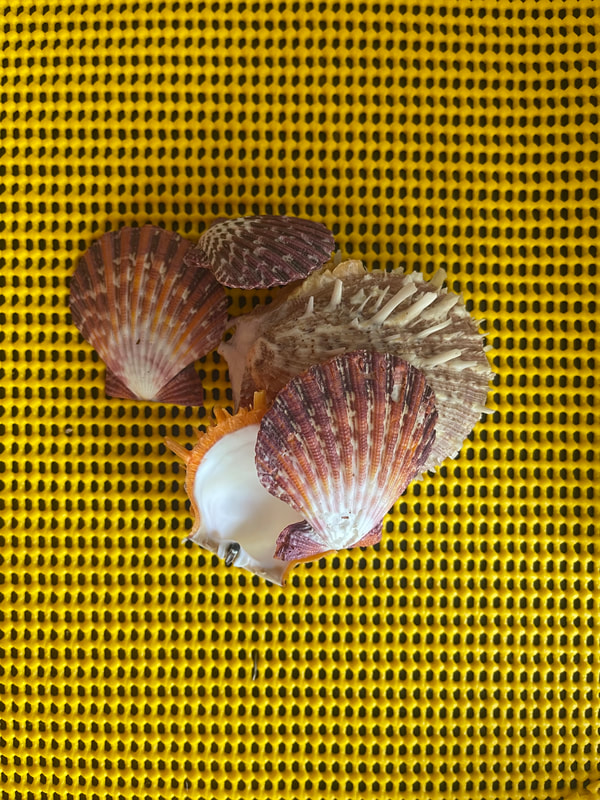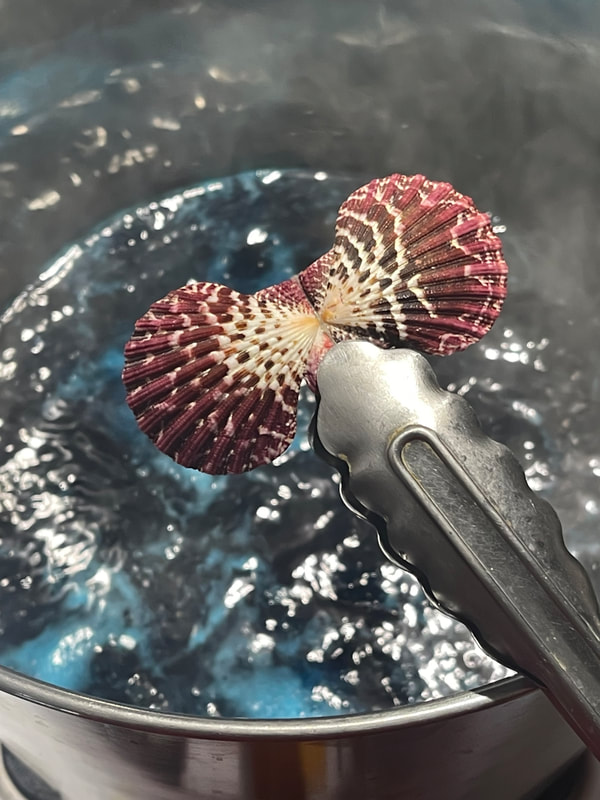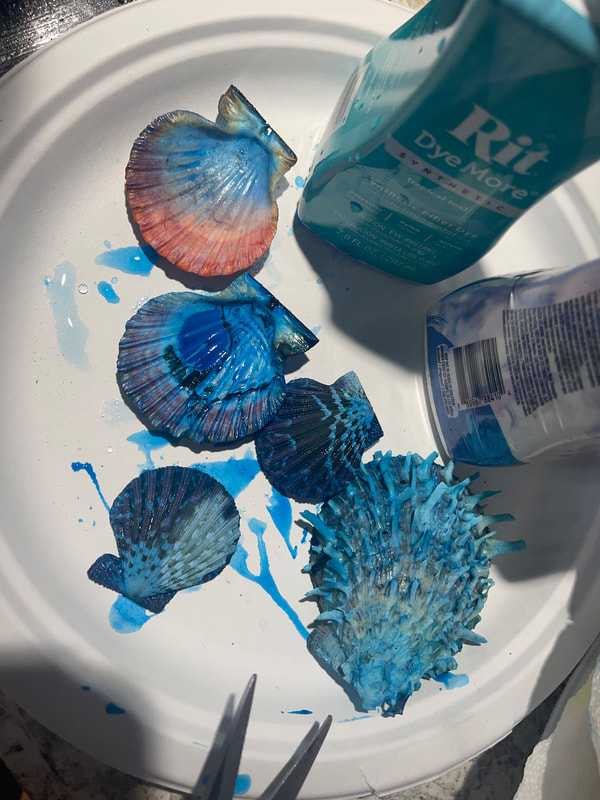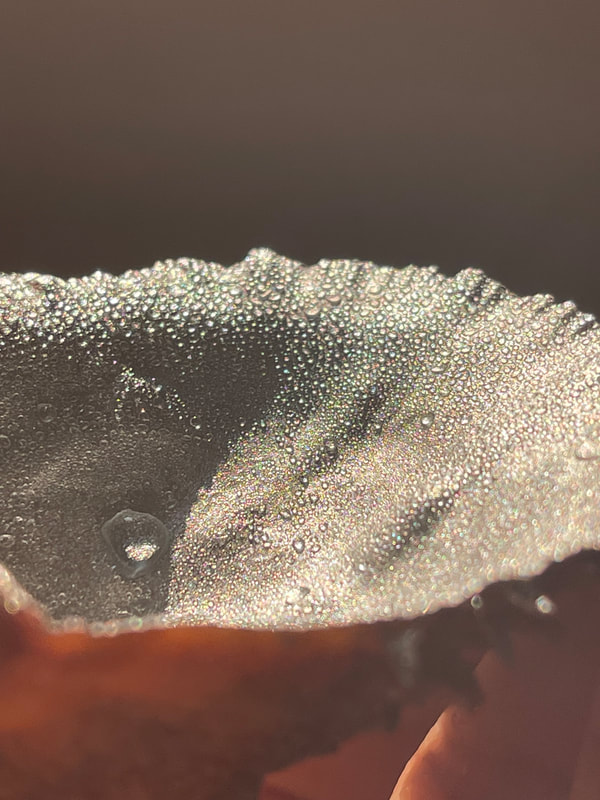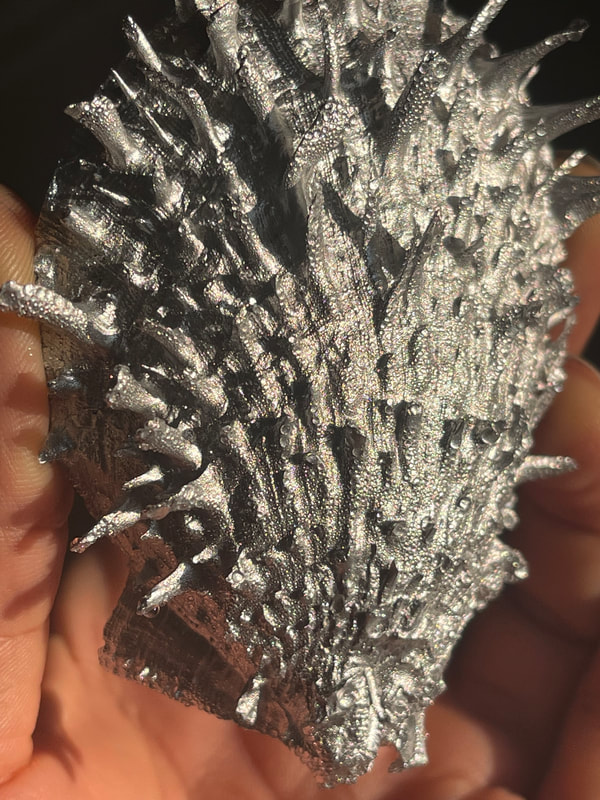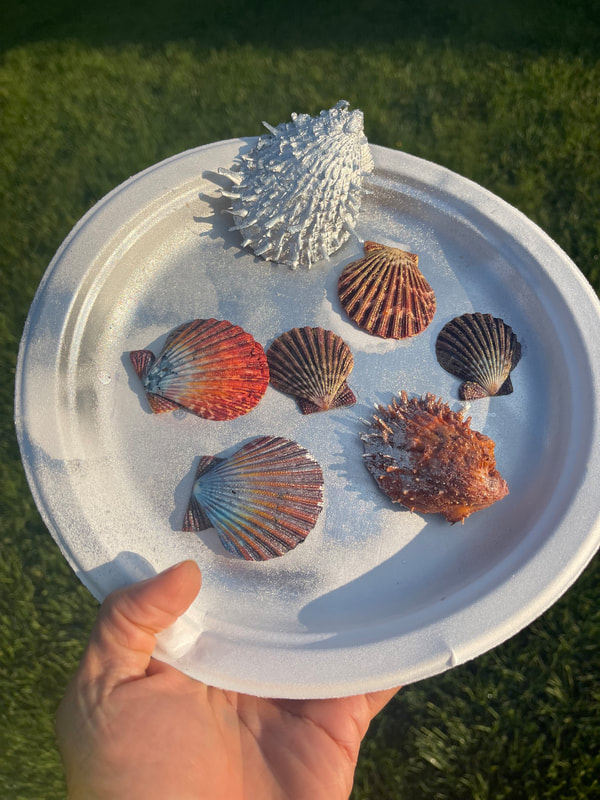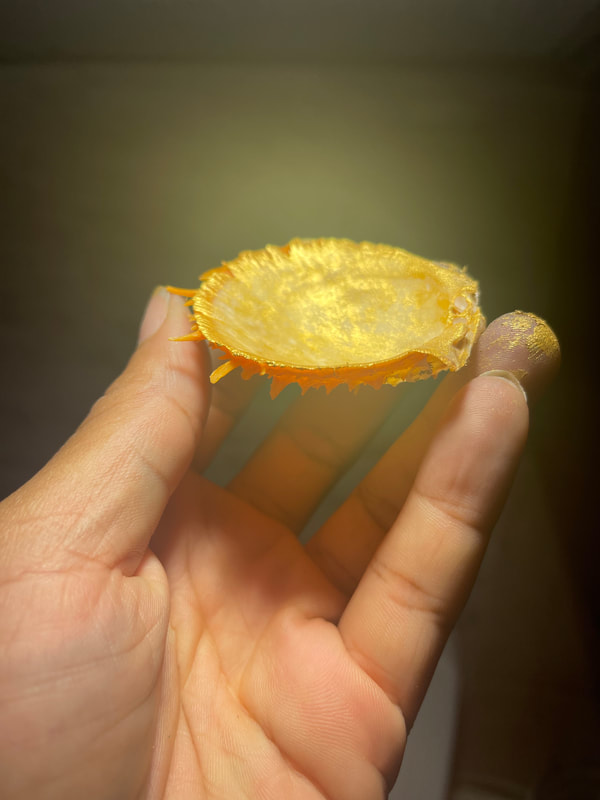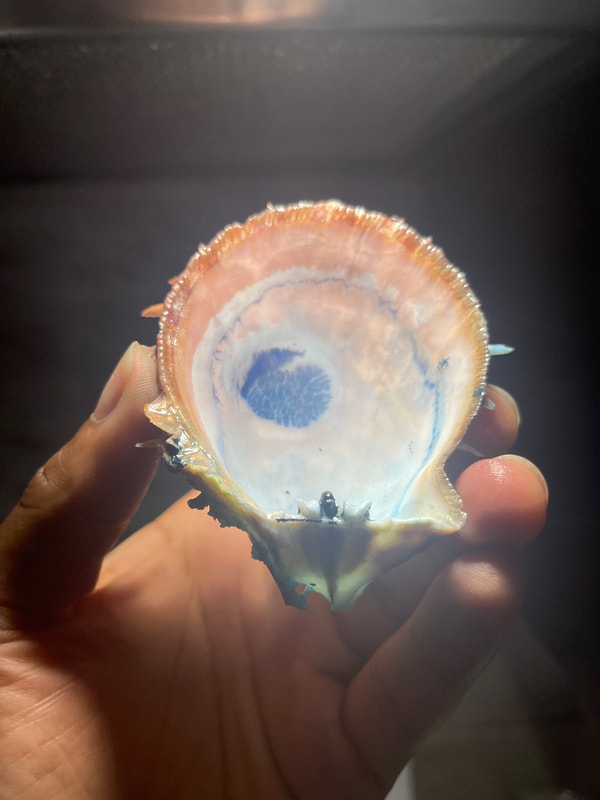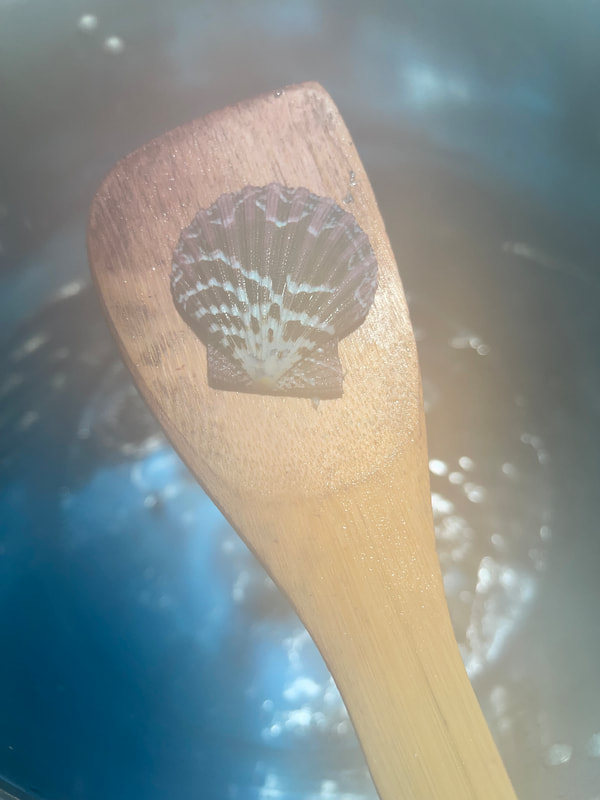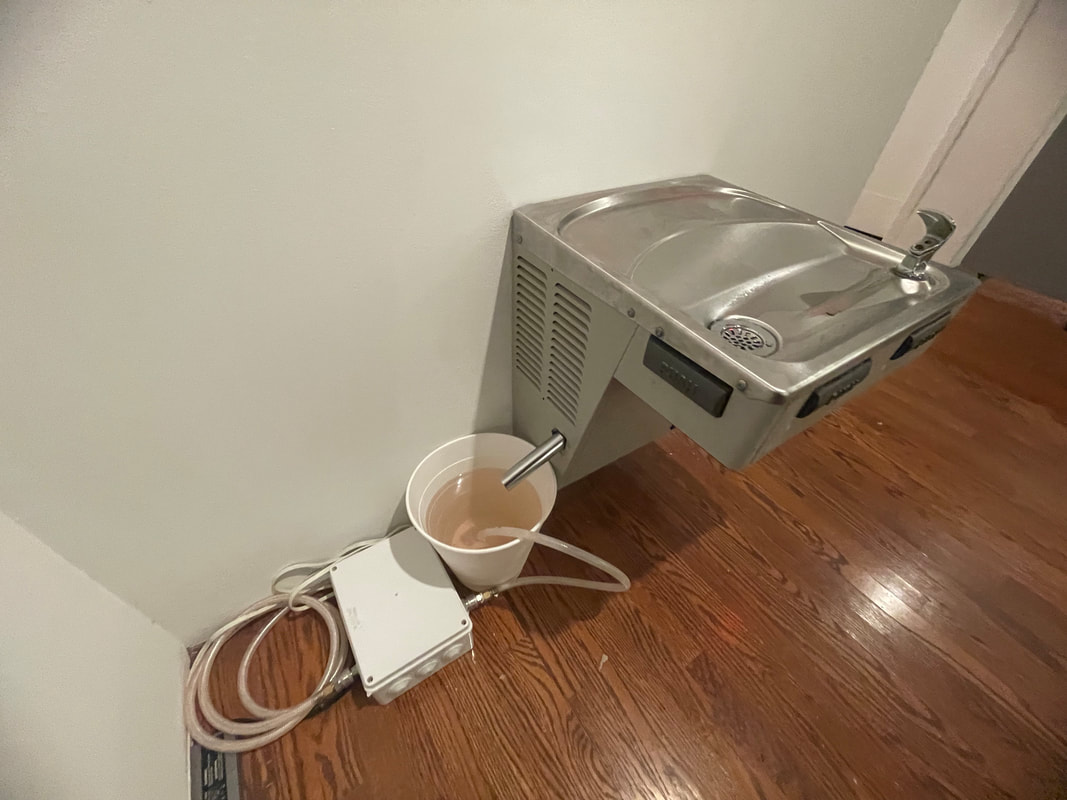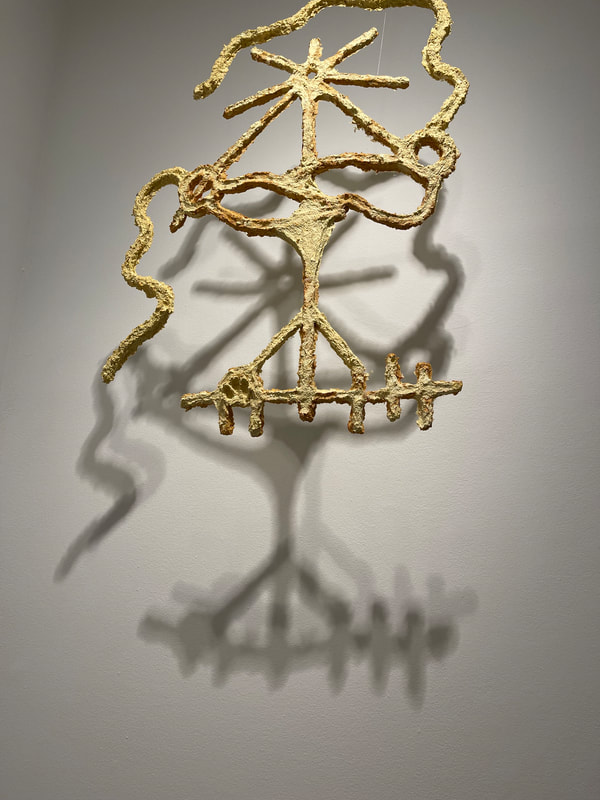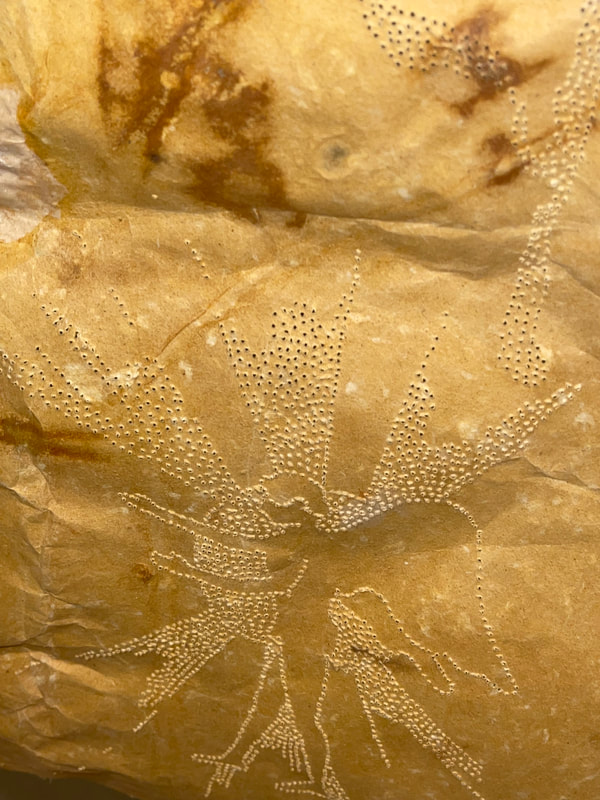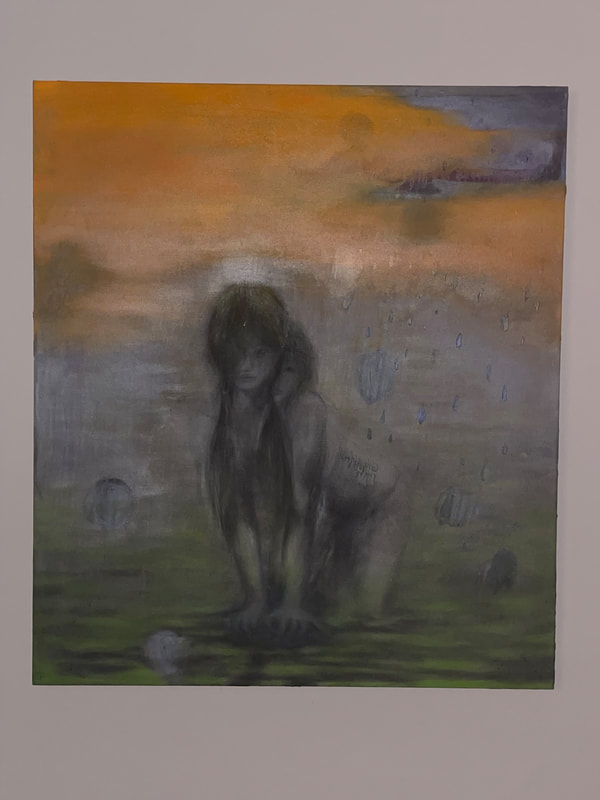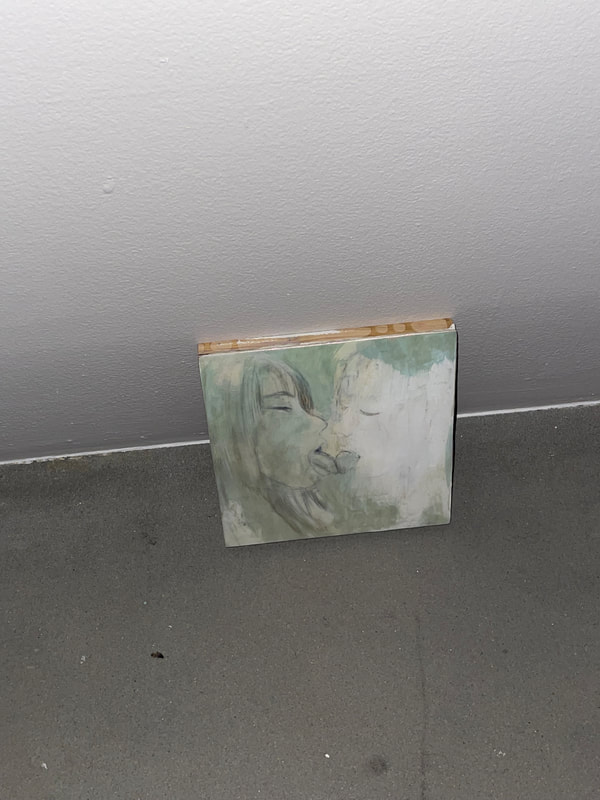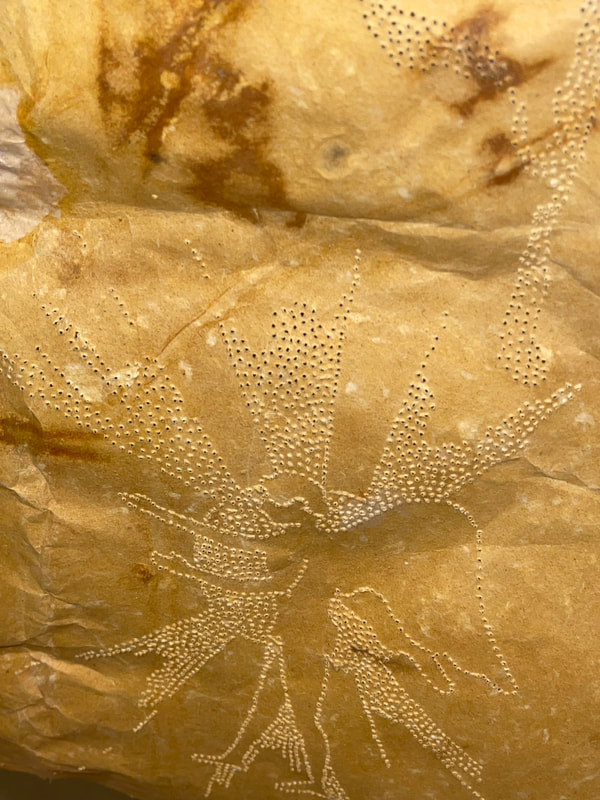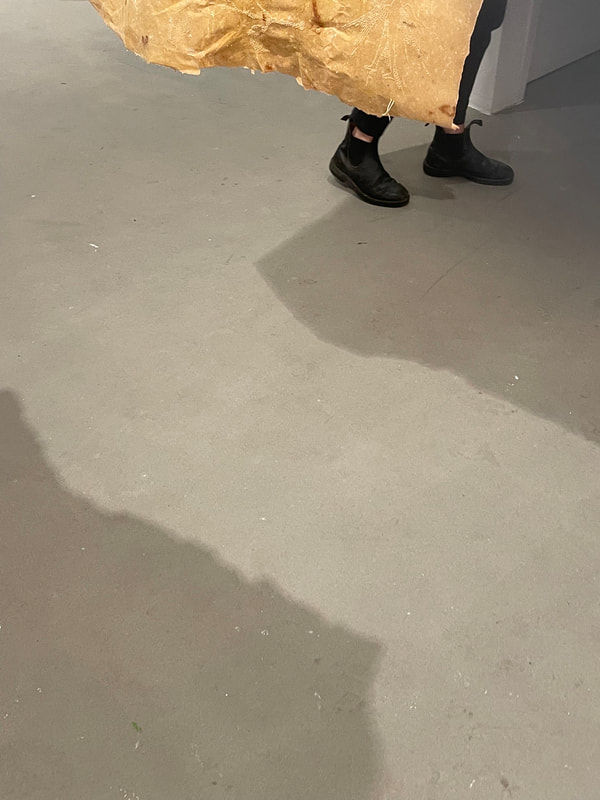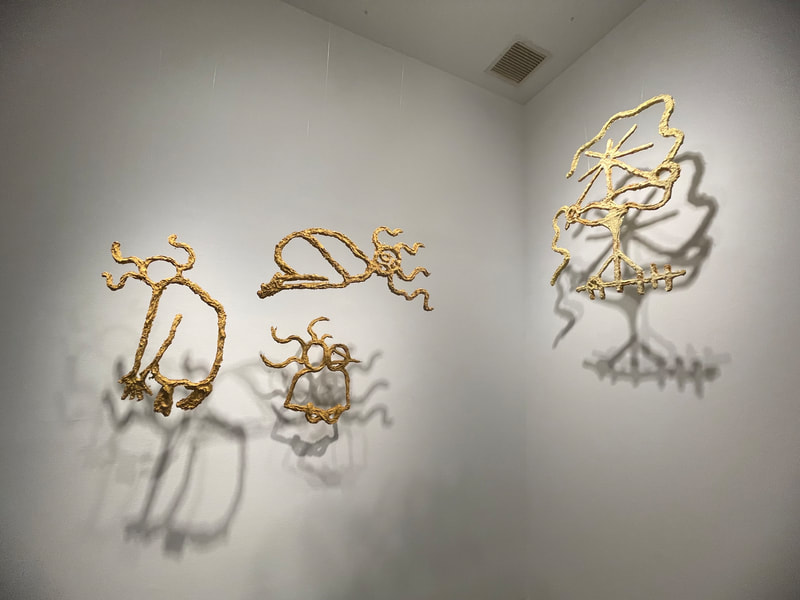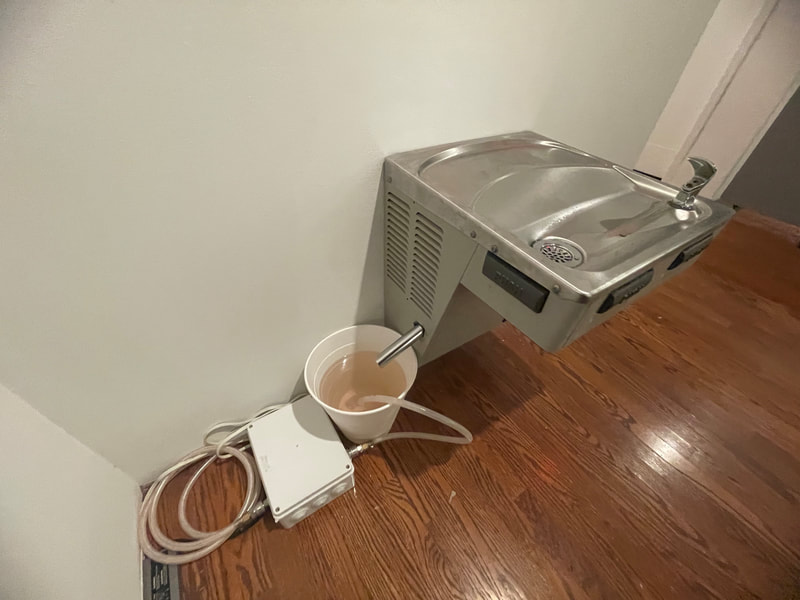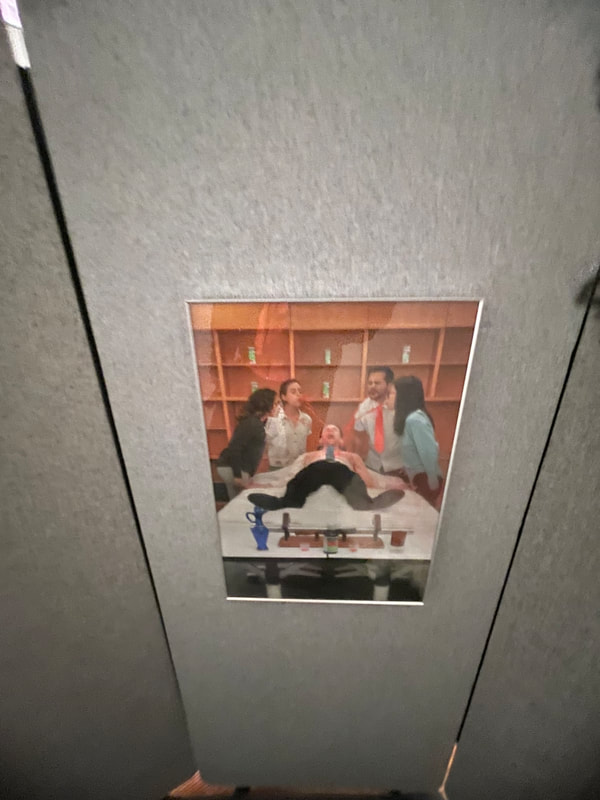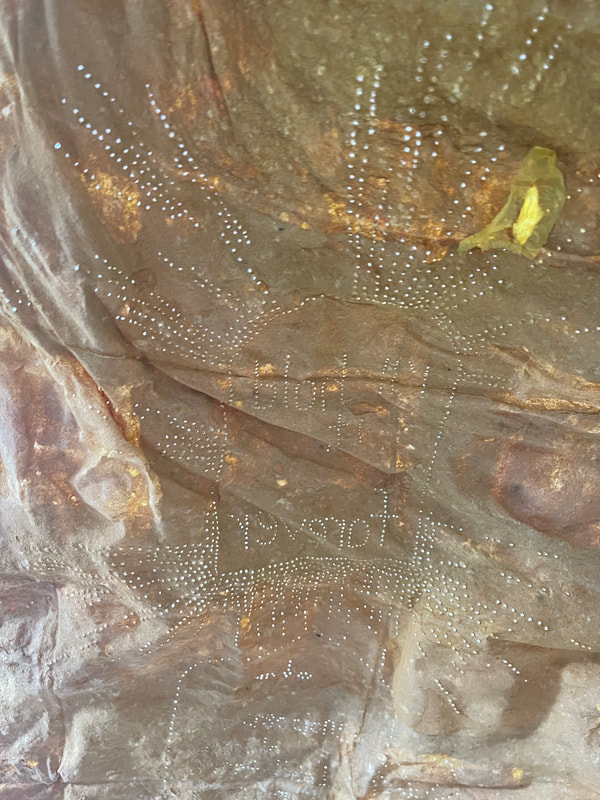The Gift in The Action An eager knife protrudes into the encampment of a hard shell. Stabbed, the oyster rings, calling for a safe haven in the darkness of warm waters, yet lingering pain seems to hold: again and again, teased, as the hard metal edge grazes the surface. Again the knife plunges, through the slight gap finally opening the body; like a smile without constraint, the air is swept out and unfurls in raucous laughter. Aroused by the calm of the luminous interior, an energetic print of tropical waters ripples. Racing to reach for my stock pile of dye and paint. I reach for chartreuse (and anything that will take me off this predictable Earth). Unfortunately, the green won't merge with the shell, so I switch to red, scarlet, turquoise, and periwinkle. My consecutive attempts to evolve theses shields, lay at the bottom of this metal basin (a quick scrub brings back the fresh from factory sheen). Bubbling and churning, the lapped waves of dye bring color to the bleached battle grounds that I’ve flayed. Ponderous visions of retired homes tear like quick seams floating above the pot: here my curiosity buoy. Plunged beneath opaque waters, halves and pieces circle the lagoon. Plumes of steam shift as metal claws aid my deep sea exploration. Retrieved from the depths, yet still incomplete, stillness is no longer here in these color treated homes. Hurried in my pursuit of success, I accept that I must sacrifice a shell to the microwave's intensity. Again my success is not found. I realize that my desires are satisfied in the failure, the mess, a delirium of quaking possibilities and combinations: a play in a crucible, where my attempts to dip into dormant hopes brings dissimilar worlds together through a roaring flame and agile hands.
Gilding is next. True to my roots in maximalism, I run to the next shell and shift to make this layer formidable and delightful. My hands locate one of two cans of metallic spray paint. Pushing off the launch pad, my steps grace down a pooling of padded steps. Hovering over tired laced shoes and stank boots, I’m at the door with my treasure and supplies in my hand. My hands unfold a tired sheet of college memorabilia (not my alumna, but someone that doesn’t know that its missing, or I just never cared to bring it back). I stake my right foot onto wet grass, shivering from the cold and discomfort, I reach the marked spot for my next stretch of confidence to erupt. Suddenly, I’m chiseling into the inner worlds of these slain beauties. Slashes of silver connect to the depths of a Uraninan sea’s fallen soldiers. By the third held breath they have been covered and dusted with clear coat, gold tones and silver spray. Together they could be a world of splendor cast in honey suckle rays, until tomorrow, when Tariq settles in a dusky blue sky.
0 Comments
Loosie: NYU Steinhardt MFA Thesis Part II Wednesday, May 3, 2023 5pm-7pm Loosie: NYU MFA Thesis Part II Participants: Xingzi Gu, Maria Scultado, Lizzy Chemel, Neil Allen-Flowers The Virginia and Muriel Pless Building expands with their hosting of Loosie: an MFA group thesis show. Tonight’s opening is filled with the sweet chaos of a mixed crowed: enclaves of chatter fill the otherwise quiet Steinhardt facade. Circumventing six rooms, each is set with a series of drawings, paintings, ceramics, or videos from the artists. We start our journey on the left and swing into the right to follow down conjoining rooms. Upon inspection we see the first glimmers of work that greeted us from the street. Grief renders the body like the heart: nearly lifeless, stiff, and heaving through shallow pumps of blood. Similarly, we see the pulsing yellow shadows through the gallery. Swinging softly in the passing breeze, yellow paper reminiscent of juvenescent depictions of the sun reverberate throughout each piece, leaving long shadows to dissipate along the stark white walls and sandy poured floors. Looking through Maria Scultado’s hovering works of figural outlines made of masses of pigmented paper pulp, some several inches away while others float 3 feet or more from any hard surface, hang like fleeced skin. Their shadows cling to the perimeter of the gallery: osmotic they push through the walls and stain hands with goopy turmeric yellow paper. We wonder, “The very thing that creates a shadow cannot banish it.” Each piece seems to absorb the light that surrounds it, filling the long night with a haunting presence that seems to mock the idea of joy and release. Still we wonder is there a cynicism here that is bringing us deeper? Or are we just another set of sculptures taking up space in the light, yet where is my shadow cast in this carousel of light. Neil Allen-Flowers's worlds are nestled between Scultado’s pieces. Flower’s works are in two connected rooms. The first looks and feels like a doctor’s office waiting room where a series of monitors and televisions play a slow video of the artists altarpiece. On the left wall a placard notes the use of Robitussin: calling out its ineffective medicinal use and its hidden benefit (to some) of being a hallucinogenic. Dyed pink like syzrp, Neil Allen-Flowers's exploration of religious delirium, obsesión and lust become gruesome displays of fetishized spit play within the second room. Photographs of the artist and crew spit sharing are elevated on cozy blue cubicle partitions. Within these blue shrines rest and recovery are indicated, yet hard to acquire as workout equipment, sculptures, or relics obstruct the space. Within the protection of blue, a blanket coated in pieces of juicy pink spit-up quivers in the corner, while a pink fountain seems to stand idle in the opposing corner, dyed pink from what I would assume is a stand in for the over the counter hallucinogen Flowers’s work calls to mind Andres Serrano’s Piss Christ, 1987, with his clear satire of private sacrosanct performance. Moving towards the back of the building, we begin to shift into a cosmology of Scultado’s sculpted linear figurations and sigils: cracked re-glued stricken with pained emotions, yet still loved. You would think that a group of stars would be warm, yet at this proximity we see them cold and huddling for some sense of warmth, to which they themselves cannot either feel or produce. Continually, we see touches of light in the shadows where we are teased with the ideas of emotional release and the substantial warmth of pained tears. Walking around these wrinkled perforated sheets of turmeric paper (3’x5’ / 2’x3’) look like they are moulded by the heat of tears and expressive anger. Scultado’s torqued surfaces are set with ripples: like fists against a pillow filled with muffled screams. Each panel assembled from tens of smaller sheets of paper are cut meticulously, slicing though to show clear pain diffused by such a happy color. As they hang, supported from the ceiling, they hold onto light on, which seems to bleed through and around their echoing chamber of secrets. ‘Vuélveme un vida’ and ‘Doy me vida’ are inscribed amongst forlorn angels. Scarred and sculpted the paper is a kin to a palimpsest of a holy mountain vandalized by youth, whom carry a fervor for life that elders dismiss as a cry for help (I wonder if it is all too late for help to be any good). Who saves the angels when they come to earth and their hearts become to heavy for their wings to lift? After exiting to the north edge of the gallery, ceramic sculptures are set upon a shelf, two pedestals, walls and the floor. Here Lizzy Chemel’s thorny crowns surround an amalgamation of rocky substrate. The white clay body has a matte pebbled finish, looking rough enough to be abrasive, yet delicately encircles the nape of this stoney creature. On the shortest stage, to our left a pair of Noh masked vessels welcome the space: one in a dark metallic finish separates into a lid and a base with five square handles; the other is a continuous bead in a slow wet green. The gleam of the glaze enchants the audience. Looking from above the eyes and mouths are voids into the vessels, slightly agape. One imagines their preciousness filling with a sacred sacrifice, which is boiling or bubbling from beneath filling the voids of their slit mouths and minuscule pupils. Smoking in black charred skin, another tactile masterpiece lays on the concrete floor. Possibly cast from a play set or dog house, a Lincoln-log style abode is erected on the floor. Looking through its tiny side window, we stoop down and peer through the open entrance. The intensity of material reminds us of shou sugi ban and other methods of decoration and preservation. Here the charred remains of home once cherished, lie abandoned, these pieces teeter between a perceived fragility and the tenderness of their craftsmanship: buoyed by the concerted effort to explore artistic expression and identity.
Lastly, we enter Kat’s (Xingzi Gu) space, an expansive section of the gallery where tinted green and yellow lights frame her 4x6’ paintings. Kat’s paintings are diffused charcoal figural depictions intermingling with washes of vivid oil paint that effortlessly hold onto space with color rich gradients. Curiously, one large 4x6’ painting switches back and forth like a lenticular screen, as two heads appear layered on the same shoulders connected from the neck down. The chimera is posed like a Hustler centerfold at the beach: her head turning on itself tethered to a lover whom lives within her skin. Looking amongst these paintings, visions of lesbian/queer intimacy breach the surface, as washes of color intermingle with the ideas of companionship, lust, and play. The gradients behind these figures evoke feelings of traditional Chinese and Japanese prints: atmospheric landscapes and recounts of life in feudal society. Images of love being passed between youthful lovers, notes written in a secret code or a precious dance shared between tongues wandering through landscapes of love. One wonders why one painting seems to be subtly different. Within it: a woman/girl is walking down a street, alone, in the middle of the day. She seems at ease in her cadence and enjoys the peace and warmth of the sun. Through this piece we are presented with self-love. Unifying these paintings variable like temperature each painting holds a specific degree of love. Our worlds are touched by the edges of grief and the proverbial sadness that seems to lead like the call of night, masked in an inky summer heat, we weep, in joy and rage of the release. Our tears sliding down our face come to the ground beneath. We take a break to collect our thoughts, and we find ourselves in the cycle of love: giving, receiving, building, repairing. To what cost does our investment in Love become a detriment or a disaster? Perhaps the words that we know can never fill in that answer alone, that’s the importance of our actions, no? Proof of our action is here in the legacy of our memory and the pleasure or pain that remains. With a deep gratitude this show has taken a place in our hearts, we see the confidence of a new group of NYU Steinhardt Fine Art Masters. Gaze into the future of art and social development. We are thankful to have been a part of the audience. CONGRATULATIONS!!! Written by Asanté Mills Edited by Isis Davis Marks Thank you for your friendship The First Time Written in the stars, lines of fate seem to circumvent, shifting like deep ocean currents. Mine are riddled with guilt and shame, soft from a comfort that keeps me "safe". Now, I am emerging from the depths of my world of pain and fear to join the light once again. I'll be looking to relationships with friends and family for support instead of waiting for a rescuer. Parts of me are weary of this new leaf, that suddenly seems to be emerging. It's been a challenge to make my world something worthwhile, I see that it's a matter of perspective. However, I know that I cannot stay in a place of understanding without putting the thought into action. This is my first attempt.
|
Author
just a 20 something trying Archives
Categories
|
